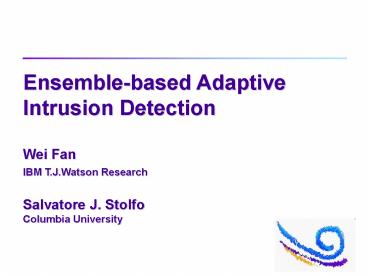Ensemble-based Adaptive Intrusion Detection PowerPoint PPT Presentation
1 / 27
Title: Ensemble-based Adaptive Intrusion Detection
1
Ensemble-based Adaptive Intrusion Detection Wei
Fan IBM T.J.Watson Research Salvatore J.
Stolfo Columbia University
2
Data Mining for Intrusion Detection
Connection Records
(telnet, 10,3,...)
Feature Construction
(ftp,10,20,...)
Training Data
Label Existing Connections
Intrusion Detection Model
Inductive Learner
3
Some interesting requirements ... ...
- New types of intrusions are constantly invented
by hackers. - Most recent coordinated attacks on many ebusiness
websites in 2000. - Hackers tend to use new types of intrusions that
intrusion detection system is unaware of or weak
at detecting them successfully. - Data mining for intrusion detection is a very
data-intensive process. - very large data
- revolving patterns
- real-time detection
4
Question
- When new types of intrusions are invented, can we
quickly adapt our existing model to be able to
detect these new intrusions before they cause
more damages? - If we don't have a solution, the new attack will
make significant damage. - For this kind of problem, having a solution that
is not completely satisfactory is better than
having no solution.
5
Naive Approach - Complete Re-training
Existing Training Data
Merged Training Data
New Data
NEW Intrusion Detection Model
Inductive Learner
6
Problem with the Naive Approach
- Since data (existing plus new) will be very
large, it takes a long time to compute a
detection model. - By the time, the model is constructed, the new
attack probably will have already made enough
damage to our system.
7
New Approach
New Data
NEW Model
Learner
Combined Model
Existing Model
Key point we only compute model from the data
on new types of intrusions only
8
How do we label connections?
a new connection
existing model
connection type unrecognized
NEW Model
normal or previously known intrusion types
normal or new intrusion types
9
Basic Idea
- Existing model is built to identify THREE classes
- normal
- some type of intrusions
- and anomaly some connection that is neither
normal nor some known types of intrusions. - anomaly detection - we use the artificial
anomaly generation method (Fan et al, ICDM 2001)
10
Anomaly Detection
- Generate "artificial anomalies" from training
data similar to "near misses". - Artificial anomalies are data points that are
different from the training data. - The algorithm concentrates on feature values that
are infrequent in the training data. - Distribution-based Artificial Anomaly (Fan et al,
ICDM2001)
11
Four Configurations
- H1(x) existing model.
- H2(x) new model.
- They differ in how H2(x) is computed.
- and how H1(x) and H2(x) are combined
- and how a connection is processed and classified.
12
Configuration I
13
Configuration II
14
Configuration III
15
Configuration IV
16
Experiment
- 1998 DARPA Intrusion Detection Evaluation Dataset
- 22 different types of intrusions.
17
Experiment
- Sequence to introduce intrusions into the
training data to simulate new intrusions are
being invented and launched by hackers - 22! unique sequences
- we randomly used 3 unique sequences.
- The results are averaged.
- RIPPER
- unordered rulesets
18
3 Unique Sequences
19
Measurements
- All results on the new intrusion types
- Precision
- If I catch a potential thief, what is the
probability that it is a real thief? - Recall
- What is the probability that real thieves are
detected? - Anomaly Detection Rate classified as anomaly
- Other classified as other types of intrusions.
20
Precision Results
21
Recall Results
22
Anomaly Detection Rate
23
Other Detection Rate Results
24
Summary of results
- The most accurate is Configuration 1 where
- new model is trained from normal and the new
intrusion type - all predicted normal and anomalies by the old
model is examined by the new model. - Reason
- Existing model's precision to detect normal
connection influences combined model's accuracy. - New data is limited in amount. Artificial
anomalies generated from new data is limited as
well.
25
Training Efficiency
26
Related Work (incomplete list)
- Anomaly Detection
- SRI's IDES use probability distribution of past
activities to measure abnormality of host events.
We measure network events. - Forrest et al uses absence of subsequence to
measure abnormality. - Lane and Brodley employ a similar approach but
use incremental learning approach to update
stored sequence from UNIX shell commands. - Ghosh and Schwarzbard use neural network to learn
profile of normality and distance function to
detect abnormality. - Generating Artificial Data
- Nigam et al assign label to unlabelled data using
classifier trained from labeled data. - Chang and Lippman applied voice transformation
techniques to add artificial training talkers to
increase variability. - Multiple classifiers
- Asker and Macline "Ensembles as a sequence of
classifiers"
27
Summary and Future Work
- Proposed a two-step two classifier approach for
efficient training and fast model deployment. - Empirically tested in the intrusion detection
domain. - Need to test if it works well for other domains.

